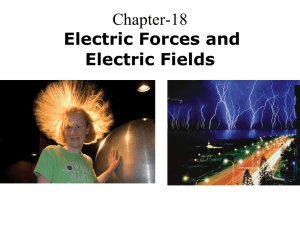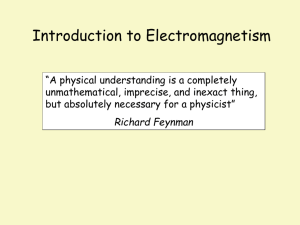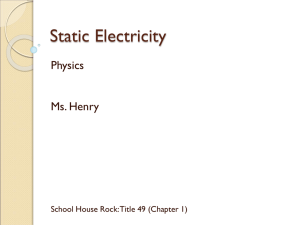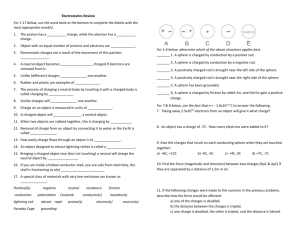Chapter 18 Electricity at Rest
advertisement
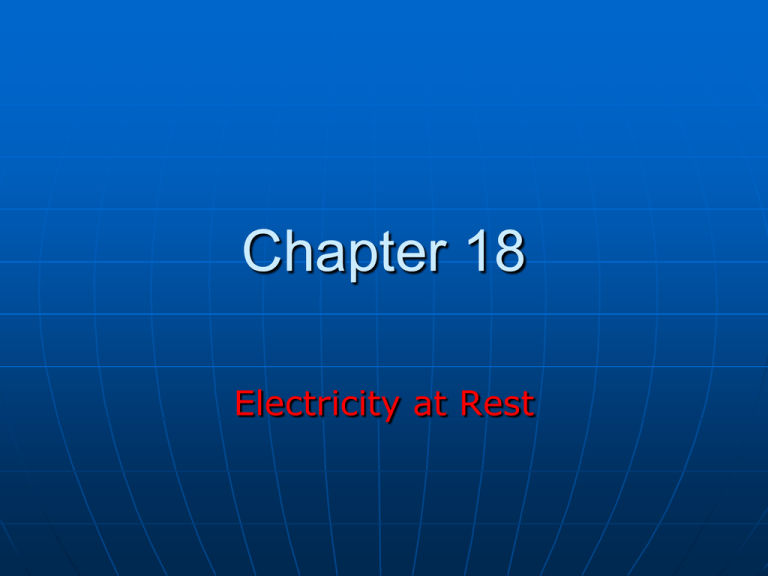
Chapter 18 Electricity at Rest A Bit of History Ancient Greeks • Observed electric and magnetic phenomena as early as 700 BC Found that amber, when rubbed, became electrified and attracted pieces of straw or feathers Magnetic forces were discovered by observing magnetite attracting iron A Bit More History William Gilbert • 1600 • Found that electrification was not limited to amber Charles Coulomb • 1785 • Confirmed the inverse square relationship of electrical forces Electrostatics: Study of charges at rest More Properties of Charge Nature’s basic carrier of negative charge is the electron • Gaining or losing electrons is how an object becomes charged Electric charge is always conserved • Charge is not created, only exchanged • Objects become charged because negative charge is transferred from one object to another Properties of Charge, final Charge is quantized • All charge is a multiple of a fundamental unit of charge, symbolized by e Quarks are the exception • Electrons have a charge of –e • Protons have a charge of +e • The SI unit of charge is the Coulomb (C) e = 1.6 x 10-19 C Conductors Conductors are materials in which the electric charges move freely • Copper, aluminum and silver are good conductors • When a conductor is charged in a small region, the charge readily distributes itself over the entire surface of the material Insulators Insulators are materials in which electric charges do not move freely • Glass and rubber are examples of insulators • When insulators are charged by rubbing, only the rubbed area becomes charged There is no tendency for the charge to move into other regions of the material Semiconductors The characteristics of semiconductors are between those of insulators and conductors Silicon and germanium are examples of semiconductors Charging by Conduction A charged object (the rod) is placed in contact with another object (the sphere) Some electrons on the rod can move to the sphere When the rod is removed, the sphere is left with a charge The object being charged is always left with a charge having the same sign as the object doing the charging Charging by Induction When an object is connected to a conducting wire or pipe buried in the earth, it is said to be grounded A negatively charged rubber rod is brought near an uncharged sphere The charges in the sphere are redistributed • Some of the electrons in the sphere are repelled from the electrons in the rod Charging by Induction, cont The region of the sphere nearest the negatively charged rod has an excess of positive charge because of the migration of electrons away from this location A grounded conducting wire is connected to the sphere • Allows some of the electrons to move from the sphere to the ground Charging by Induction, final The wire to ground is removed, the sphere is left with an excess of induced positive charge The positive charge on the sphere is evenly distributed due to the repulsion between the positive charges Charging by induction requires no contact with the object inducing the charge Coulomb’s Law Coulomb shows that an electrical force has the following properties: • It is inversely proportional to the square of the separation between the two particles and is along the line joining them • It is proportional to the product of the magnitudes of the charges Q1 and Q2 on the two particles • It is attractive if the charges are of opposite signs and repulsive if the charges have the same signs Coulomb’s Law, cont. Mathematically, Q1Q2 F k 2 r k is called the Coulomb Constant • k = 8.99 x 109 N m2/C2 Typical charges can be in the µC range • Remember, Coulombs must be used in the equation Remember that force is a vector quantity Coulomb’s Law Coulomb’s law q Q FE k 2 r q More than two charges? Q SUPERPOSE them!!! F F1 F2 F3 ... Electrical Field Maxwell developed an approach to discussing fields An electric field is said to exist in the region of space around a charged object • When another charged object enters this electric field, the field exerts a force on the second charged object Electric Field, E F E E q Force on a positive unit charge (N/C). Therefore, E-field superposable!!! If there is E-field, there is force!!! • (+)-charge feels force // E-field • (-)-charge feels opposite to E-field. This does not mean the positive (negative) charge will follow the E-field line. Electric Field of Point Charge Electric field at distance r from a point charge Q is Q Ek 2 r Electric field from many charges: superposition (vector sum) E E1 E2 E3 ... Direction of Electric Field The electric field produced by a positive charge is directed away from the charge • A positive unit charge would be repelled from the positive source charge Direction of Electric Field, Cont The electric field produced by a negative charge is directed toward the charge • A positive unit charge would be attracted to the negative source charge Electric Field Lines A convenient aid for visualizing electric field patterns is to draw lines pointing in the direction of the field vector at any point These are called electric field lines and were introduced by Michael Faraday Electric Field Lines, cont. The field lines are related to the field by • The electric field vector, E, is tangent to the electric field lines at each point • The number of lines per unit area through a surface perpendicular to the lines is proportional to the strength of the electric field in a given region Electric Field Line Patterns Point charge The lines radiate equally in all directions For a positive source charge, the lines will radiate outward Electric Field Line Patterns For a negative source charge, the lines will point inward Electric Field Line Patterns An electric dipole consists of two equal and opposite charges The high density of lines between the charges indicates the strong electric field in this region Electric Field Line Patterns Two equal but like point charges At a great distance from the charges, the field would be approximately that of a single charge of 2q The bulging out of the field lines between the charges indicates the repulsion between the charges The low field lines between the charges indicates a weak field in this region Electric Field Patterns Unequal and unlike charges Note that two lines leave the +2q charge for each line that terminates on -q Uniform Electric Field between Parallel Charged Plates Constant force on a charged particle Example Determine electric field 30 cm from a 5C point charge Example Determine the force on an electron between two parallel plates. (E=6 x 104 N/C) Example More electrostatic problems Potential—Potential Difference Potential at a point away from a point charge Q Q Vp k J/C=Volt r Work done to move an unit charge from infinity to point P Q positive, positive work Q negative, negative work Many point charges --- superposition Q1 Q2 Vp k k ... r1 r2 Potential Difference VAB VB VA Work done to move an unit charge from A to B Work done to move charge Q W QV W can be either positive or negative Example Car battery (12V) Work done to move a proton from A to B Work done to move an electron from A to B Potential Energy Potential energy of charge Q: QV When a charge moves through potential V, gain (loss) kinetic energy Proton accelerated by 3MV, find its speed. Television Tube More about proton Charge particle with charge ne Examples Two 6 C charges 10 cm apart, find V and E at various points Acceleration of a proton by electric field E=500 N/C. Coulomb force between two identical charges
